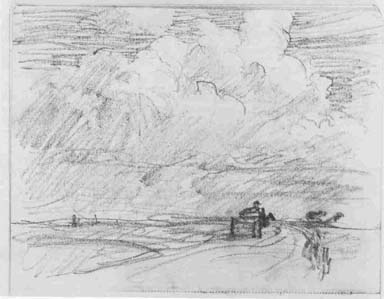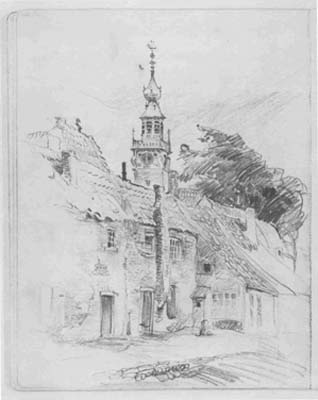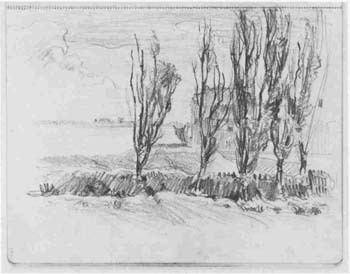
Annual Bulletin 2, 1978-1979
Home
Français
Introduction
History
Annual Index
Author &
Subject
Credits
Contact




A. Y.
Jackson in France, Belgium and Holland:
A 1909 Sketch book
By Rosemarie L. Tovell
Pages 1 | 2
| 3
| 4
| 5
On Monday, 12 July, Jackson
took the train to Leiden and then the tram to Katwijk aan Rijn, where he
found lodgings at 208 Kerkstraat. He reserved a room for a period to begin
on 16 July. Afterwards he walked back to Leiden with only a few of his
belongings, and explored Leiden for five hours before taking the train
to Amsterdam. That same evening he wrote a letter to his mother (10) on three
sheets of paper torn out of the sketch book between pages 10 verso and
11 recto. Although he took the sketchbook with him to Leiden and
Amsterdam, there are no drawings that can be linked with either of these
cities. In Amsterdam, Jackson first planned to visit the Rijksmuseum,
"one of the finest picture galleries in the world, where the Night Watch
by Rembrandt is, and the Maris brothers, and Anton Mauve...." (11)
Jackson wrote that he was hoping, on Wednesday, 14 July, to go on
a day-long excursion to Volendam and Edam, but there is no positive evidence
from drawings in the sketch book that he actually made this trip.
On Friday, 16 July, Jackson returned
to Katwijk aan Rijn for a three-week stay, joining up with Hardy, the only
other foreign artist in the village. (12) There are no drawings in the sketch
book that can be positively identified with Katwijk aan Rijn, but there
are two drawings - a landscape (fig. 4) and a cloud study, probably of the
Katwijk area, on pages 17 recto and 18 recto - that may have
been done at Katwijk aan Zee. Both seem to fit the description Jackson
gave of a walk, "jusqu'à les [sic] bord de la mer, mais
le vent est si fort et le temps si desagreeable [sic]...." (13) In
this letter, written at Katwijk aan Rijn on two pages torn from the sketch
book between pages 18 verso and 19 recto, Jackson indicates
that bad weather plagued most of his three-week sojourn. During this time,
Jackson seems to have worked primarily in oil, with at least three known
oil sketches depicting Katwijk subjects. (14)
Sometime after 2 August, A. Y. moved on to "the ancient
and decayed town of Veere...much frequented by artists...." (15) Veere
was apparently not "too tidy and cleaned up," (16) for the time spent there
was most productive for A. Y. He made many oil sketches even though "the
summer is not the best of time to sketch there, too much green as usual
and I am not fond of greens, and somehow my [oil] sketches did not
satisfy me. l threw all of them away." (17) Not all his paintings were
thrown away, however. There are at least two oil sketches that can be identified
as depicting Veere subjects, (18) and the sketch book identifies a third one
that has disappeared. Most of the drawings in the sketch book were done
at Veere. They fall into a group from pages 18 verso to 33 recto.
Besides a few landscapes, figure studies, the Radhuis (town hall) and
drawings of the village streets, the two predominant subjects, drawn many
times, are the Groote Kerk with its curious dome-topped tower (pp. 18v,
23v, 25r, 28v, 3Or, and 33r; figs 8-13) and a windmill (pp. 1v, 26r,
and 32r; figs 14-16). The windmill cannot be positively identified
from other sources as one at Veere, but the two major drawings of this
subject are found in the middle of the Veere group. Jackson enjoyed Veere,
and reluctantly left only when his money ran out and his railway excursion
fare had nearly expired. (19)
A. Y. Jackson left Veere for Paris on 24 August. He stayed in Paris for
a few days, but by 1 September he was back in Episy at Mme Goix's, where
he would stay except, possibly, for one brief visit to Paris, until
25 November. (20) At least three of the drawings in the sketch book were
done during the second stay at Episy: two sketches of the Canal du Loing
(pp. 35r and 35v; figs 18 and 19) and a sketch of a roadside landscape
(p. 34r; fig. 22). Situated close to this Episy group are two sheets with
strip or frieze-like drawings of the Dutch coast and sea (pp. 38r and 31v;
fig. 23). All of these drawings are directly or indirectly related to paintings
to be discussed later.
Jackson's Drawing Styles
Drawing can serve many purposes for the painter. The drawings in the
sketch book illustrate the major types: finished drawings, studies, and
preliminary sketches for oils. As can be expected from the young apprentice
rapidly gaining a mastery of his craft, there are a variety of drawing
styles. From an examination of these drawing types and styles, we can see
the growing maturity of Jackson's art and some of his early working methods.
Street and Radhuis, Veere (p. 19r; fig. 5) is a finished composition,
drawn in the late nineteenth-century
academic style. The composition is an oval with the greatest detail
at the centre, drawn in short sharp lines. As the eye moves out to the
edges, the details become fainter, giving way to roughly-drawn generalized
shapes at the extremities. Although Jackson prefers this format for architectural
subjects, variations can also be found in his landscapes such as the study,
"View across the Veergat" (p. 28r; fig. 6). In this drawing, the foreground is
crisply and emphatically drawn. However, the details do not fade away at the edges
of the composition; rather, they fade away as the eye moves towards the horizon.
In contrast with the academic style, Jackson also developed a style characterized
by the broad, blunt, vigorous pencil strokes that capture the atmosphere
of the wind and rain-swept landscape of Katwijk aan Zee (p. 17r; fig. 4).
Details such as the trees and the horse-drawn cart are suppressed for
the form and shading of cumulus clouds overhead. This quickly-drawn landscape,
which subordinates details to the effects of light, form, and atmosphere,
is closer to the style of Jackson's mature pencil sketches. Where Jackson
decided to work these drawings into paintings, he would use as references
the quick studies of the detail elements, such as the horse and cart studies
on page 20 recto (fig. 7). The sketchbook is full of these small
detail drawings (figure studies, tree branches, grassy sand dunes, cows,
horses and barges). They may have been simply exercises in observation,
and references, but in at least one case a detail drawing of a canal in
the sketchbook served as the starting point for a painting - The Canal
du Loing - as will be described later.
A third drawing style is exemplified
by the sketch of the Groote Kerk, Veere on page 33 recto (fig. 10).
It blends the two previously-described styles in that the broad, roughly-drawn
elements are combined with a rendering of detail. Jackson's concern or
purpose here is to capture the effects of flickering light on the surface
of the cathedral and make it one with the landscape and weather.
At this stage in A. Y. 's career, it
is difficult to say that he had developed a drawing style uniquely his
own. The angular shading, the short pencil strokes, and the rather pedestrian
treatment of buildings give little indication of the bold contour lines,
sway-backed buildings, and rapid dots and squiggles for shading that characterized
his mature Canadian drawings.
Next Page | Tonal Coding System
1 | 2
| 3
| 4
| 5
Annual Index | Author & Subject | Credits | Contact
This digital collection
was produced under contract to Canada's Digital Collections program,
Industry Canada.
"Digital
Collections Program, Copyright
© National Gallery of
Canada 2001"